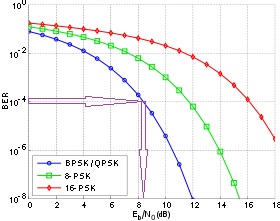- Table of contents
- Link Budget
Link Budget¶
Required C/N0 and C/N¶
The first step in order to do a link budget, is to determine the required Eb over N0 we need to achieve a given BER, for the modulation we are using.
This value can be obtained by using theoretical curves as shown in the figure below.

Figure 1 : BER curves
For our project, the wanted bit error rate was BER=10-4, and the modulations we considered were BPSK, QPSK and 2-FSK.
Therefore, we researched the theoretical value for these values at BER=10-4 and we implemented it in our code (in the VI required Eb/N0.vi). In our project, we have not considered coding, but if we had, we would have had to substract the required Eb/N0 by the coding gain.
Once we had the required Eb/N0, we could calculate the required C/N0 (carrier-to-noise spectral density ratio) using the formula:
C/N0=Eb/N0*Rb
Rb being the information bit rate.
Knowing the bandwidth of the signal, the carrier to noise ratio, C/N can be calculated using:
C/N=1/B*C/N0
B being the bandwith of the noise, but different definitions exist. Here we used the bandwidth of the RF carrier.
C/N0 calculation¶
In the project, we only considered an AWGN channel (Additive White Gaussian Noise) and therefore we did not include interference in the link budget. So the formula we used to calculate the total C/N0 is:
(C/N0)t-1 = (C/N0)d-1 +(C/N0)u-1
where (C/N0)d and (C/N0)u are respectively the downlink and the uplink carrier-to-noise spectral density ratio.
To calculate those ratios, the only loss we considered was the free space path loss, and therefore we did not include the rain attenuation losses , the atmospheric gases attenuation or the depointing of the antenna. The formulas we used in C/N0d.vi and C/N0u.vi are:
(C/N0)d_dBHz= EIRP_satellite + (G/T)ground -k -Ld_fspl; (C/N0)u_dBHz= EIRP_ground + (G/T)satellite -k -Lu_fspl;
where the EIRP is the Equivalent Isotropic Radiated Power (in dBW), which is the product of the transmitted gain Gt and the power transmitted to the input terminals of the antenna. We suppose here that the user of the program knows the EIRP of the antenna and of the satellite.
The G/T (in dBK-1) is called the "figure of merit" where G is the receive antenna gain (in dB) and T is the total system temperature (dBK). We suppose that the user knows as well the G/T of his ground station and of the satellite. If that is not the case, the user can refer to the book Satellite communications system by Gerard Marat and Michel Bousquet to do the calculation or http://www.aticourses.com/sampler/sat_comm_sys_engineering.pdf.
k is the boltzmann constant equal to -228.6 in dBJ.dBK-1.
Lu_fspl is the uplink free space path loss (in dB) and Ld_fspl the downlink free space loss (in dB as well) that can be defined as:
Lu=10log((4*pi*d*Fu*/c)²); Ld=10log((4*pi*d*Fd*/c)²);
where Fu and Fd are respectively the uplink and the downlink frequencies and c the velocity of light in the vacuum. Those are calculated in the VI Free space path loss.vi.
Tests¶
To test the link budget, we started with values of geostationnary satellites, that are easier to find on the internet and on our lecture, and we compared with our values.
References¶
M. Michel BOUSQUET & M. Gérard MARAT. Satellite communications system. 5th edition, 2009.
Example of a satellite link budget : http://www.aticourses.com/sampler/sat_comm_sys_engineering.pdf
Eb over N0 calculation : https://en.wikipedia.org/wiki/Eb/N0
